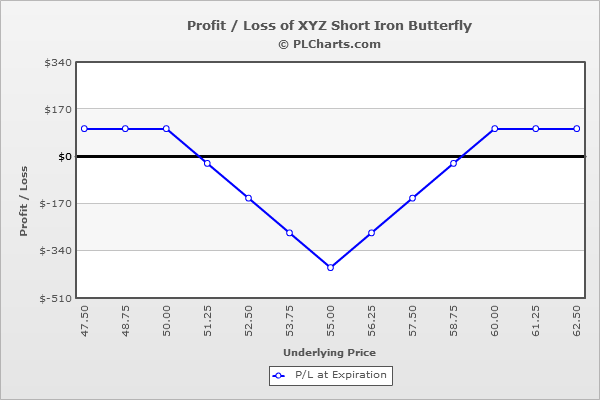Short Iron Butterfly

Risk: limited
Reward: limited
General Description
Entering a short iron butterfly entails selling (1) put at a lower strike, buying (1) put at a middle strike, buying (1) call at the same middle strike and selling (1) call at a higher strike (same expiration month, strikes are equal distance). It's essentially a combination of a lower strike bear put spread and a higher strike bull call spread, and it's similar to a short iron butterfly except the long puts use the same strike.
(draw a short iron butterfly risk diagram here)
The Thinking
You're not bullish or bearish, but you do think a big move is coming and along with it, an expansion in volatility. You employ a lower strike bear put spread, which achieves max profitability when the underlying drops (although profitability is capped) and a higher strike bull call spread, which achieves max profitability when the underlying rallies (although profitability is capped). If you are correct, if the stock moves big (preferably above the upper strike or below the lower strike) you'll profit.
Example
XYZ is at $55.00, and your analysis says a big move is coming (earnings or some other big announcement). You buy (1) 55 put for $3.00 and sell (1) 50 put for $1.00. Then you buy (1) 55 call for $3.00 and sell (1) 60 call for $1.00. The net debit is $4.00.
Above the highest strike, max profitability is achieved. The puts are out-of-the-money and expire worthless, and the calls are in-the-money can cancel each other out. As an example, at $65, the 50 put will be worthless ($1.00 profit), the 55 put will be worthless ($3.00 loss), the 55 call will be $10.00 ($7.00 profit) and the $60 call will be worth $5.00 ($4.00 loss). The net of this is a $1.00 profit.
Below the lowest strike, max profitability is also achieved. The calls are out-of-the-money and expire worthless, and the puts are in-the-money can cancel each other out. As an example, at $45, the 50 put will be worth $5.00 ($4.00 loss), the 55 put will be worth $10 ($7.00 profit), the 55 call will be worthless ($3.00 loss) and the $60 call will be worth ($1.00 profit). The net of this is a $1.00 profit.
At $55, your max loss occurs. All calls and puts expire worthless, and your loss is equal to the net debit charged for initiating the trade. At $55, both the 50 put and 60 call will be worthless ($1.00 profit each) and the 55 call and put will be worthless ($3.00 loss each). The net of this is a $4.00 loss.
The PL chart below graphically shows where this trade will be profitable and at a loss.

|

